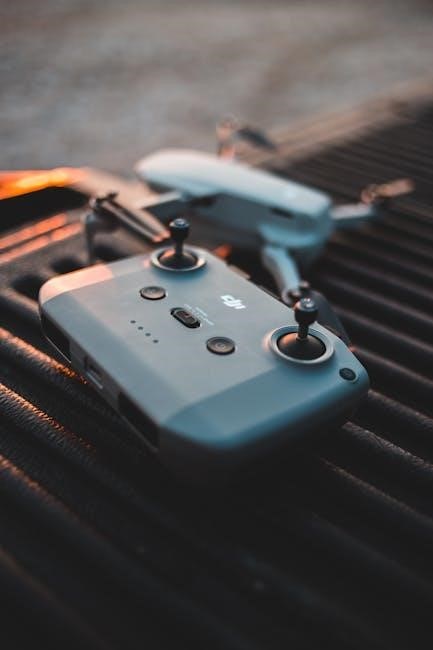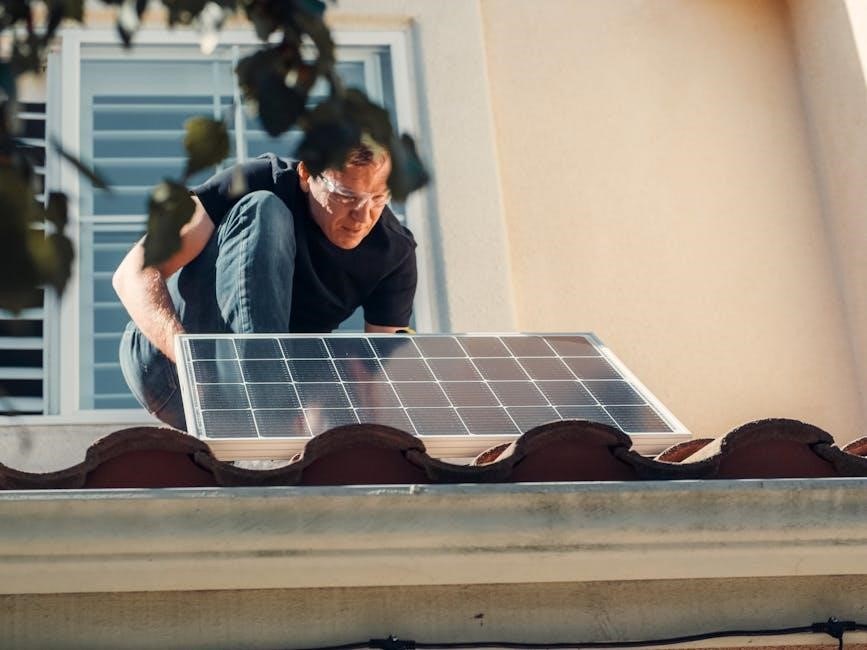mppt solar charge controller manual

Welcome to the MPPT Solar Charge Controller Manual! This guide provides essential insights into maximizing solar energy efficiency‚ ensuring optimal battery charging‚ and maintaining system safety․
Overview of MPPT Solar Charge Controllers
An MPPT solar charge controller is a critical component in solar energy systems‚ designed to optimize energy harvesting from solar panels to batteries․ Using advanced Maximum Power Point Tracking (MPPT) technology‚ these controllers efficiently convert solar energy‚ ensuring maximum power extraction even in varying conditions․ They offer high conversion efficiency‚ automatic battery voltage detection‚ and multi-stage charging to protect and extend battery life․ Compatible with various battery types‚ MPPT controllers are essential for reliable and efficient solar power management in off-grid and renewable energy systems․
Importance of Using an MPPT Solar Charge Controller
Using an MPPT solar charge controller is crucial for maximizing solar energy efficiency and protecting your system․ It ensures optimal energy transfer from panels to batteries‚ reducing losses and improving overall performance․ MPPT technology dynamically adjusts to varying solar conditions‚ capturing maximum power and extending battery life․ Unlike PWM controllers‚ MPPT controllers offer higher efficiency‚ advanced safety protections‚ and compatibility with diverse battery types․ This makes them indispensable for reliable‚ high-performance solar systems‚ ensuring your investment delivers long-term energy savings and sustainability․

Key Features of MPPT Solar Charge Controllers
MPPT controllers offer high efficiency‚ advanced power tracking‚ multi-charging modes‚ and compatibility with various battery types‚ ensuring optimal energy utilization and system protection․
Automatic Battery Voltage Detection
MPPT solar charge controllers feature automatic battery voltage detection‚ simplifying setup by identifying system voltage (12V‚ 24V‚ 36V‚ or 48V) upon connection․ This eliminates manual configuration errors‚ ensuring compatibility with various battery types․ The controller adjusts charging parameters dynamically‚ optimizing energy transfer and preventing overcharge scenarios․ This intelligent feature enhances safety‚ efficiency‚ and convenience‚ making it ideal for users with varying system voltages or those upgrading their battery configurations․ It ensures seamless operation across different setups without requiring complex adjustments․
Multi Charging Modes
MPPT solar charge controllers offer multi charging modes to cater to different battery types and charging needs․ These modes include Bulk‚ Absorption‚ Float‚ and Equalization‚ ensuring optimal charging at every stage․ Additionally‚ some controllers feature custom modes for specific applications‚ such as lithium battery charging or load management․ These modes enhance flexibility‚ allowing users to tailor charging processes to their system requirements․ They also provide advanced protection‚ preventing overcharge and ensuring battery longevity․ This versatility makes MPPT controllers suitable for a wide range of solar energy systems and applications․
Advanced Safety Protections
MPPT solar charge controllers are equipped with advanced safety protections to prevent system damage and ensure reliable operation․ These include overcharge‚ over-discharge‚ and short-circuit protection․ Temperature compensation and thermal management features maintain safe operating conditions‚ while reverse polarity protection prevents electrical faults․ Controllers also offer load control modes‚ such as dusk-to-dawn lighting and user-defined settings‚ enhancing safety and functionality․ These robust protections ensure the longevity of your battery and solar system‚ providing peace of mind for users in various applications․
High Efficiency and Conversion
MPPT solar charge controllers excel in maximizing energy conversion efficiency‚ often achieving up to 30% more energy harvest compared to PWM controllers․ Advanced algorithms dynamically adjust to optimize power transfer from solar panels to batteries‚ ensuring minimal energy loss․ This technology efficiently handles varying PV and battery voltages‚ maximizing energy capture even in fluctuating conditions like cloud cover or temperature changes․ The high-efficiency design ensures your solar system performs at its best‚ delivering reliable power and extending battery life for optimal energy utilization․
Compatibility with Various Battery Types
MPPT solar charge controllers are designed to work seamlessly with a wide range of battery chemistries‚ including LiFePO4‚ AGM‚ Gel‚ and Flooded Lead-Acid․ This versatility ensures optimal charging performance across different battery types․ The controller automatically detects system voltage and adjusts charging parameters to match the battery’s requirements․ Advanced models also support temperature compensation‚ ensuring precise charging even in extreme climates․ This compatibility makes MPPT controllers ideal for various applications‚ from small off-grid systems to large renewable energy projects‚ providing reliable and efficient battery management․

How MPPT Technology Works
MPPT technology efficiently tracks the maximum power point of solar panels‚ optimizing energy extraction and dynamically adjusting to varying light and temperature conditions․
Maximum Power Point Tracking (MPPT) Algorithm
The MPPT algorithm continuously tracks the solar panel’s maximum power point‚ adjusting current and voltage for optimal energy extraction․ It analyzes real-time data to maximize efficiency‚ ensuring the system adapts to changing light and temperature conditions․ This advanced technology enhances energy transfer from panels to batteries‚ minimizing losses and improving overall system performance․ By dynamically optimizing power flow‚ the MPPT algorithm ensures your solar setup operates at peak efficiency‚ supporting various battery types and system configurations for reliable energy storage and use․
Understanding PV Voltage and Battery Voltage
Understanding PV voltage and battery voltage is crucial for efficient energy transfer․ Solar panels produce varying voltage depending on light conditions‚ while batteries require stable voltage for charging․ The MPPT controller acts as a bridge‚ optimizing voltage and current from the panels to match the battery’s needs․ This ensures maximum energy transfer and prevents overcharging or undercharging․ The manual details how to configure these voltages‚ ensuring compatibility and safety for different battery types‚ and highlights the controller’s role in protecting your system and maximizing energy utilization; Proper voltage management is key to system longevity and performance․
Stages of Charging: Bulk‚ Absorption‚ and Float
The MPPT controller manages charging through three key stages․ The Bulk stage rapidly charges the battery to 80% of its capacity․ The Absorption stage maintains a constant voltage to reach full charge․ Finally‚ the Float stage keeps the battery topped up at a safe voltage to prevent overcharging․ These stages ensure efficient‚ safe‚ and optimal battery charging‚ adapting to the battery’s needs and preventing damage from overcharging or undercharging․
Installation and Setup Guide
Install your MPPT controller by connecting solar panels‚ battery‚ and load․ Follow step-by-step instructions for mounting‚ wiring‚ and configuring settings to ensure safe‚ efficient operation․
Step-by-Step Installation Process
Begin by disconnecting the battery to ensure safety․ Mount the MPPT controller in a well-ventilated area‚ away from direct sunlight․ Connect the solar panels to the controller’s input terminals‚ ensuring polarity is correct․ Next‚ link the battery to the controller’s output terminals‚ matching the voltage․ Secure all connections firmly․ Finally‚ reconnect the battery and test the system by monitoring the display for proper operation․ Always follow the manufacturer’s wiring diagram and safety guidelines to avoid damage or risk․
Mounting and Placement Recommendations
Mount the MPPT controller in a shaded‚ well-ventilated area to prevent overheating․ Ensure it is securely fastened to a sturdy surface using provided brackets․ Keep it away from flammable materials and moisture․ For optimal performance‚ maintain a distance from high-voltage electrical components․ Avoid direct exposure to sunlight to prevent temperature fluctuations․ Proper placement ensures efficient operation and longevity of the controller‚ safeguarding your solar system’s reliability and efficiency․ Always refer to the manual for specific mounting guidelines tailored to your model․
Initial Settings Configuration
Begin by setting the battery type‚ system voltage‚ and charging parameters according to your solar setup․ Use the LCD display or app to navigate through menus and select options like battery chemistry (e․g․‚ LiFePO4‚ AGM) and voltage (12V‚ 24V‚ etc․)․ Enable charging modes such as bulk‚ absorption‚ and float․ Refer to the manual for default settings and adjust as needed for optimal performance․ Ensure all configurations are saved to prevent loss during power cycles․ Proper initial setup ensures efficient energy management and safeguards your system’s longevity․

Safety Precautions and Protection Features
Ensure safe installation and operation by following guidelines to prevent overcharge‚ over-discharge‚ and short-circuit risks․ Built-in protections enhance system reliability and longevity․
Essential Safety Measures for Installation
Always disconnect solar panels and batteries before installation to prevent short circuits․ Ensure proper grounding of the controller to avoid electrical hazards․ Use rated wires and connectors to handle maximum current safely․ Install the controller in a well-ventilated‚ dry area away from flammable materials․ Avoid over-tightening terminals to prevent damage․ Never touch electrical components while the system is live․ Use a temperature sensor for accurate battery monitoring․ Follow the manual’s specific instructions for your controller model to ensure safe and efficient operation․ Improper installation can lead to system damage or safety risks․
Overcharge‚ Over-discharge‚ and Short-Circuit Protection
MPPT solar charge controllers include built-in protections to prevent overcharging‚ over-discharging‚ and short circuits․ Overcharge protection regulates battery voltage to avoid damage from excess energy․ Over-discharge protection stops battery drainage below a safe threshold‚ preserving lifespan․ Short-circuit protection detects and interrupts abnormal currents‚ ensuring system safety․ These features automatically respond to potential hazards‚ safeguarding both batteries and solar panels․ They are critical for maintaining reliable operation and preventing irreversible damage to your solar energy system․
Temperature Compensation and Thermal Management
MPPT solar charge controllers incorporate temperature compensation to adjust charging parameters based on battery temperature‚ ensuring optimal charging and preventing overcharging․ Thermal management features‚ such as heat sinks and intelligent cooling systems‚ prevent overheating‚ which can degrade battery performance and lifespan․ These mechanisms ensure the controller operates efficiently across varying environmental conditions‚ maintaining reliability and extending system longevity․ Accurate temperature sensing and adaptive adjustments are vital for preserving battery health and ensuring consistent energy storage and delivery․

Troubleshooting Common Issues
Identify and resolve common issues like error codes‚ connection problems‚ or performance inefficiencies․ Check for loose connections‚ verify system configuration‚ and ensure proper installation to maintain optimal functionality․
Identifying and Diagnosing Problems
Common issues with MPPT controllers include error codes‚ low charging efficiency‚ or unexpected shutdowns․ Start by checking the display for fault codes‚ which indicate specific problems like overvoltage or short circuits․ Verify all connections to ensure they are secure and free from corrosion․ Review the system configuration to confirm proper settings for battery type and voltage․ If issues persist‚ consult the manual or contact technical support for assistance․ Regular monitoring and maintenance can help prevent these problems and ensure reliable performance․ Always refer to the troubleshooting section for detailed solutions and guidelines․
Understanding Error Codes and Alarms
MPPT controllers often display error codes to indicate system issues‚ such as overvoltage‚ short circuits‚ or temperature extremes․ These codes help users identify and address problems quickly․ Common alarms include warnings for low battery voltage or excessive current․ Refer to the manual for a list of specific error codes and their meanings․ Understanding these codes enables users to troubleshoot effectively‚ ensuring system reliability and safety․ Always resolve issues promptly to prevent damage to the controller or battery․ Regular checks can help avoid alarms and maintain optimal performance․
Resolving Connection and Communication Issues
Connection issues with your MPPT controller can often be resolved by checking wire connections for tightness and correctness․ Ensure all terminals are securely attached to the correct ports․ If communication with a monitoring system fails‚ restart the controller or check firmware compatibility․ For Bluetooth or Wi-Fi issues‚ ensure the device is in range and properly paired․ Refer to the manual for specific troubleshooting steps․ Using tools like VictronConnect can help diagnose and resolve communication errors․ Always verify settings match your system configuration for seamless operation․
Optimizing Performance and Efficiency
To optimize your MPPT solar charge controller’s performance‚ ensure proper alignment and orientation of solar panels for maximum sunlight exposure․ Regularly clean panels to avoid energy loss from dirt or debris․ Adjust charging parameters to suit your battery type and environmental conditions․ Utilize the controller’s built-in monitoring system to track real-time data and make informed adjustments․ For advanced systems‚ consider integrating remote monitoring software to fine-tune settings and maximize energy harvest․ Proper maintenance and firmware updates also play a key role in sustaining peak efficiency and longevity of the system․

Maintenance and Repair Tips
Regularly inspect connections‚ clean surfaces‚ and update firmware to ensure optimal performance․ Check for loose wires and tighten them to prevent power loss and damage․
Regular Maintenance for Optimal Performance
Regular maintenance is crucial for ensuring your MPPT solar charge controller operates efficiently․ Start by inspecting all electrical connections to prevent power loss due to loose wires․ Clean the controller’s surfaces and solar panels to remove dirt and debris‚ which can reduce energy absorption․ Additionally‚ check the battery terminals for corrosion and tighten them if necessary․ Updating the firmware periodically will also enhance performance and add new features․ Finally‚ monitor the system’s temperature to ensure it remains within safe operating limits‚ preventing overheating and potential damage․ These steps will help maintain optimal functionality and extend the lifespan of your MPPT controller․
Updating Firmware for Enhanced Features
Updating the firmware of your MPPT solar charge controller is essential for unlocking enhanced features and improving performance․ Regularly check the manufacturer’s website for the latest firmware version compatible with your model․ Download the update‚ transfer it to the controller using a USB or Bluetooth connection‚ and follow the installation prompts․ Avoid interrupting the update process to prevent potential system issues․ Once completed‚ the controller will benefit from improved algorithms‚ bug fixes‚ and new functionalities․ Always refer to the user manual for specific instructions to ensure a smooth update process․
Diagnosing and Fixing Common Faults
Faults in MPPT solar charge controllers can often be diagnosed by checking error codes‚ monitoring system performance‚ and inspecting connections․ Common issues include overcharge protection‚ short circuits‚ or communication errors․ Start by reviewing the error log or LED indicators for specific fault codes․ Ensure all connections are secure and free from corrosion․ For software-related issues‚ restart the controller or update the firmware․ If problems persist‚ consult the user manual or contact technical support for assistance․ Regular maintenance and system checks can help prevent faults and ensure optimal operation․

Choosing the Right MPPT Controller
Selecting the ideal MPPT controller involves considering system voltage‚ battery type‚ and capacity․ Ensure compatibility with your solar panels and battery chemistry for optimal performance and efficiency․
Factors to Consider: System Voltage and Capacity
When selecting an MPPT controller‚ it’s crucial to match the system voltage (12V‚ 24V‚ 36V‚ or 48V) with your battery and panel configuration․ Ensure the controller’s capacity aligns with your solar array’s maximum power output and battery bank size․ Proper sizing prevents overheating and ensures efficient energy transfer․ Always check the controller’s rated voltage and current limits to avoid system overload and potential damage․ Compatibility and correct sizing are key for optimal performance and longevity of your solar energy system․
Selecting the Right Controller for Your Battery Type
Choosing the right MPPT controller for your battery type ensures optimal charging and longevity․ Controllers are designed to support various battery chemistries‚ including LiFePO4‚ AGM‚ Gel‚ and Flooded Lead-Acid․ Verify the controller’s compatibility with your battery type‚ as some models offer specific charging profiles for lithium batteries․ Additionally‚ check if the controller supports temperature compensation‚ which is crucial for accurate charging in extreme climates․ Always consult the manual to ensure the controller’s settings align with your battery’s requirements for safe and efficient operation․
Considering Environmental and Climate Factors
When selecting an MPPT solar charge controller‚ consider environmental factors like temperature‚ humidity‚ and altitude․ Temperature compensation ensures accurate charging in both hot and cold climates‚ preventing overcharging or undercharging․ In humid environments‚ look for controllers with protective coatings or IP ratings to prevent corrosion․ High altitudes may require controllers with enhanced cooling mechanisms to maintain efficiency․ Dusty conditions may necessitate regular maintenance to ensure optimal performance․ Additionally‚ ensure the controller has surge protection to withstand extreme weather conditions like thunderstorms or hail‚ safeguarding your system’s reliability and longevity․

Advanced Features and Customization
Advanced MPPT controllers offer PC monitoring‚ remote control‚ and customizable charging parameters for tailored performance․ These features enhance system adaptability‚ ensuring optimal energy utilization and user control․
PC Monitoring and Remote Control Capabilities
Advanced MPPT controllers often include PC monitoring and remote control features‚ enabling users to track system performance and adjust settings via software or apps․ These tools allow real-time monitoring of solar input‚ battery status‚ and charging parameters․ Remote control capabilities provide flexibility‚ letting users optimize energy use and troubleshoot issues from a distance․ Compatibility with apps like VictronConnect enhances user convenience‚ offering detailed analytics and customizable settings for enhanced system management and efficiency․
Customizing Charging Parameters
Customizing charging parameters allows users to tailor their MPPT controller’s performance to specific needs․ Adjustments can be made to voltage and current settings‚ charge stages‚ and timing; This ensures optimal charging for various battery types‚ such as LiFePO4 or lead-acid․ Advanced controllers often feature programmable bulk‚ absorption‚ and float phases‚ enabling precise control over charging cycles․ These settings can be configured via the controller’s interface or through remote software‚ providing flexibility and ensuring batteries are charged efficiently and safely according to their requirements․
Integrating with Other Solar System Components
Seamless integration of the MPPT controller with other solar system components is crucial for optimal performance․ Compatibility with inverters‚ solar panels‚ and battery management systems ensures a cohesive energy setup․ Advanced controllers often support communication protocols like Bluetooth or Wi-Fi‚ enabling monitoring and control through smartphones or PCs․ Proper integration enhances system efficiency‚ simplifies monitoring‚ and allows for remote adjustments‚ ensuring a user-friendly and efficient solar energy harvesting experience․ This connectivity also supports scalable setups‚ adapting to evolving energy needs․

Warranty and Technical Support
Your MPPT controller comes with a comprehensive warranty‚ ensuring protection for your investment․ Dedicated technical support and extensive online resources are available for troubleshooting and maintenance․
Understanding Warranty Terms and Conditions
Most MPPT solar charge controllers come with a 5-year warranty‚ covering manufacturing defects and ensuring reliability․ The warranty typically includes repairs or replacements for faulty units․ Exclusions may apply for misuse‚ improper installation‚ or environmental damage․ Reviewing the warranty terms is crucial to understand coverage limits and claim procedures․ Contact the manufacturer or refer to the manual for specific details․ Proper registration and adherence to guidelines can maximize warranty benefits and protect your investment․ Always retain proof of purchase for warranty-related claims․
Accessing Technical Support and Resources
For assistance with your MPPT solar charge controller‚ refer to the comprehensive manual or contact the manufacturer’s technical support team․ Many providers offer 24/7 support via phone‚ email‚ or live chat․ Online resources include troubleshooting guides‚ FAQs‚ and video tutorials to help resolve common issues․ Additional support materials‚ such as user forums and instructional PDFs‚ are often available on the manufacturer’s website․ Ensure to register your product for access to exclusive resources and updates․ Proper documentation and proof of purchase may be required for warranty claims or technical assistance․
This manual provides a comprehensive guide to MPPT solar charge controllers‚ focusing on their features‚ installation‚ and maintenance․ It highlights the importance of MPPT technology in maximizing solar energy efficiency and ensuring safe battery charging․ Key topics include automatic voltage detection‚ multi-charging modes‚ and advanced safety protections․ The manual also covers troubleshooting‚ firmware updates‚ and selecting the right controller for specific systems․ By following the guidelines‚ users can optimize performance‚ extend battery life‚ and maintain system reliability․ This resource is essential for anyone aiming to harness solar energy effectively and safely․
final Thoughts and Recommendations
Final Thoughts and Recommendations
Investing in an MPPT solar charge controller is a smart decision for maximizing solar energy efficiency and protecting your battery system․ Always choose a controller that matches your system’s voltage and capacity․ Regular maintenance and firmware updates are crucial for optimal performance․ Consider environmental factors and battery types when selecting a model․ For troubleshooting‚ refer to the manual or contact technical support; By following these guidelines‚ you can ensure a reliable and efficient solar charging experience while extending the lifespan of your battery and solar panels․

Additional Resources
Explore recommended manuals‚ online forums‚ and manufacturer guidelines for deeper insights into MPPT solar charge controllers․ These resources offer troubleshooting tips and advanced customization options․
Recommended Reading and Manuals
For deeper understanding‚ refer to the BougeRV Sunflow MPPT Solar Charge Controller Manual‚ which covers installation‚ operation‚ and troubleshooting․ The Midnite Solar Classic MPPT Manual provides detailed insights into advanced features․ Additionally‚ explore the Victron SmartSolar MPPT Manual for comprehensive guides on system configuration․ Online forums like Solar Power Forums and manufacturer-specific resources offer valuable troubleshooting tips and user experiences․ These materials ensure optimal performance and safety for your solar charging system․
Online Communities and Forums
Engage with online communities like Solar Power Forums and Reddit’s r/RenewableEnergy to connect with experts and enthusiasts․ These platforms offer valuable insights‚ troubleshooting tips‚ and real-world experiences with MPPT controllers․ Participate in discussions to resolve common issues‚ optimize performance‚ and stay updated on the latest trends․ Many forums also provide access to user manuals‚ firmware updates‚ and manufacturer-specific guidance‚ making them an invaluable resource for both beginners and advanced users looking to enhance their solar energy systems․
Manufacturer-Specific Guidelines
Manufacturer-specific guidelines are crucial for effective MPPT solar charge controller installation and operation․ Always refer to the official manuals provided by the manufacturer‚ such as Victron Energy or BougeRV‚ for detailed instructions tailored to your specific model․ These guidelines cover installation steps‚ parameter settings‚ and troubleshooting tips‚ ensuring compatibility with your solar panels and battery systems․ Adhering to these guidelines ensures optimal performance‚ safety‚ and warranty compliance․ Visit the manufacturer’s website or support portal to access the latest documentation and updates for your MPPT controller․